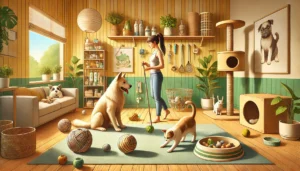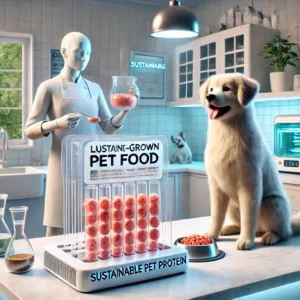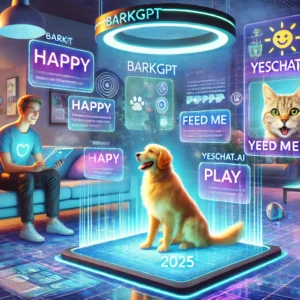
Ever felt a pang of guilt tossing out a plastic chew toy after your dog shredded it in seconds? Or maybe you’ve wondered whether your cat’s grooming supplies could harm the environment? We’re in 2025 now, and eco-friendly pet products have gone from niche luxuries to everyday essentials. From biodegradable toys and organic grooming supplies to broader discussions on sustainability, these green alternatives are redefining how we care for our furry companions.
Below, we’ll explore everything you need to know about this thriving movement—why governments are pushing for eco-conscious pet ownership, which celebrities are championing the cause, and how both older and younger generations are adapting to these changes. We’ll even delve into the global business side of things, so buckle in and let’s dig deeper into the world of sustainable pet care.
A Changing Landscape for Pet Owners
The demand for eco-friendly pet products has skyrocketed. According to PawPetsIndia, green pet items are no longer just a trend; they’re fast becoming a necessity. Whether it’s biodegradable poop bags or sustainably sourced catnip, pet parents are realizing how crucial these products are for the planet’s health.
Why the shift? For starters, climate change awareness is at an all-time high. Many of us want to minimize our carbon pawprints. Plus, an increasing number of pet product manufacturers have responded to consumer demand by offering everything from bamboo-laced chew toys to natural dog shampoos. And guess what? Our pets seem pretty happy about these changes—there’s something about a natural rope toy that just feels better in their mouths (at least, that’s my dog’s take on it).
Government Initiatives and Political Discussions
In 2025, governments worldwide are turning their attention to eco-friendly pet products. Policies encouraging green alternatives are cropping up everywhere. For instance, the U.S. Department of Agriculture has backed research grants aimed at creating compostable pet waste bags, pushing local municipalities to adopt programs that reduce landfill waste.
Meanwhile, in Europe, parliamentary debates often highlight sustainable pet care. Several nations are considering legislation that requires manufacturers to disclose the carbon footprint of their pet products on labels. In addition, some countries are offering tax incentives to companies that produce biodegradable toys or organic grooming supplies. Critics worry these measures might lead to higher prices, but supporters argue that short-term costs are dwarfed by the long-term environmental gains.
Political leaders, especially those with high-profile pet-owning backgrounds, are keen to present themselves as champions of green living. They point out that shifting to sustainable pet products is a straightforward way for citizens to make a noticeable ecological impact.
Science and Research Labs Studying Sustainable Pet Care
Behind every biodegradable chew toy or organic flea repellent, there’s a research team working to perfect it. Scientists at universities and private labs are focusing on how new materials can break down faster, leaving minimal traces in landfills. According to data from SustainableLiving.org.nz, ongoing studies aim to develop innovative textiles for pet bedding—think hemp-based fabrics that disintegrate within two years if composted properly.
Moreover, experts are researching the best ways to ensure these products remain safe and effective. Dr. Avery Chen, a materials scientist who collaborates with several eco-friendly pet brands, explains:
“We’re blending biodegradable polymers with natural fibers to craft toys that satisfy a dog’s need to chew. At the same time, we want to ensure those toys won’t release harmful residues if a pet ingests small particles.”
Such rigorous testing ensures that green pet products meet high safety standards and truly deserve their “eco-friendly” label.
Celebrity Endorsements Fueling the Trend
Celebrities love their pets, and many of them have hopped on the sustainability train. Leonardo DiCaprio, known for his environmental activism, has been vocal about encouraging fans to explore organic grooming supplies for their furry friends. Meanwhile, singers like Miley Cyrus post videos of their dogs playing with hemp-based rope toys on social media, generating a surge in online searches.
Influencers on Instagram and TikTok also rave about the best biodegradable cat litter or natural pet shampoo, often partnering with sustainable brands to showcase eco-friendly alternatives. These endorsements make green pet care feel trendy and accessible, especially for younger audiences who are already environmentally conscious.
Elderly Pet Owners: Evolving Perspectives
Let’s be honest: adopting new products can sometimes be daunting for older generations. My own grandmother used to scoff at the idea of “organic dog biscuits,” asking, “What was wrong with the treats we had back in my day?” Interestingly enough, many seniors are beginning to embrace eco-friendly products, especially when they realize the health benefits for their pets.
- Reduced Allergens: Senior pet owners dealing with respiratory issues find natural grooming products helpful, as they often have fewer irritants.
- Community Support: Local senior centers sometimes partner with nonprofits to distribute biodegradable supplies at discounted rates, bridging the gap for fixed-income seniors.
- Peace of Mind: Many older adults find comfort in knowing they’re leaving a cleaner planet for future generations.
As these individuals witness the positive effects—fewer chemical reactions, less plastic waste—they gradually warm up to the idea. Some even become local advocates, hosting workshops on how to craft homemade, eco-friendly toys out of old t-shirts or hemp twine.
Youthful Enthusiasm for Green Pet Supplies
If there’s one group spearheading the demand for eco-friendly pet products, it’s definitely the younger crowd. Gen Z and Millennials grew up in a time of heightened environmental awareness, and they’re determined to make conscious choices in every aspect of life—including pet care. They often research a brand’s entire supply chain before making a purchase. In fact, a 2024 survey found that 72% of people aged 18 to 30 consider sustainability a key factor when selecting pet products.
Social media platforms are bursting with how-to videos for making compostable dog toys or setting up zero-waste litter stations. Younger pet owners are also more inclined to support small businesses championing fair labor practices and environmentally responsible sourcing. This generational shift is a huge catalyst for the global rise in green pet care.
Global Business and Revenue Trends
Let’s talk money. As the demand for sustainable pet supplies climbs, the global market is swelling with new entrants. According to ThePetLarder, revenue from eco-friendly pet products jumped by 35% between 2023 and 2025, and experts predict even higher growth in the next few years.
- Asia-Pacific: Countries like India and China, with expanding middle classes, are witnessing a boom in sustainable pet product startups.
- North America: Established pet brands are rebranding to highlight eco-friendly lines, aiming to corner a market that’s increasingly conscious of environmental impact.
- Europe: The EU’s regulatory frameworks, emphasizing transparency and biodegradable materials, make it a prime hub for innovation in green pet care.
Large corporations often acquire smaller, eco-focused companies to meet consumers’ changing preferences. While some critics are wary of corporate “greenwashing,” many businesses appear genuinely committed to offering better, more sustainable pet products. Profits are rolling in, and with them, more resources for research and development.
Popular Eco-Friendly Pet Products Worth Exploring
In 2025, the range of green pet items seems endless. Here are a few categories turning heads:
- Biodegradable Pet Toys
- Made from hemp or natural rubber.
- Break down faster in landfills.
- Safe if chewed or ingested in small amounts.
- Organic Grooming Supplies
- Free from harsh chemicals.
- Often scented with essential oils like lavender or chamomile.
- Great for pets with sensitive skin.
- Sustainable Pet Beds
- Created from recycled plastic bottles or hemp fabric.
- Breathable, durable, and eco-friendly.
- Some brands even offer beds stuffed with shredded memory foam repurposed from old mattresses.
- Zero-Waste Pet Accessories
- Metal or bamboo food bowls, often dishwasher-safe.
- Sturdy collars and leashes from upcycled materials.
- Wooden brushes with plant-based bristles.
- Compostable Pet Waste Bags
- Typically cornstarch-based, they degrade under proper conditions.
- Many city municipalities run compost programs for dog waste to reduce landfill loads.
Government Notes on Green Pet Ownership
Some cities and countries have rolled out guidelines explicitly encouraging or even mandating more eco-friendly pet care. For example, local governments in California have introduced pilot programs that reward households that switch to biodegradable waste bags, offering rebates on certain products. Meanwhile, in Canada, tax credits are being tested to offset higher initial costs for organic grooming items.
Beyond that, a few progressive initiatives call for reduced plastic packaging in the pet industry. Lawmakers are collaborating with manufacturers to design bulk refill stations for pet shampoo, cutting down on single-use plastic. The result? A small but promising step toward a circular economy in pet care.
Political News and Legislative Moves
One might be surprised to see how passionately politicians debate over pet toys and kitty litter. But the conversation around sustainable pet care often dovetails with bigger, hot-button issues like environmental protection and consumer rights. Some notable developments:
- Pet Care & Climate Talks: Environmental committees in multiple countries have started discussing pet ownership’s impact on emissions. This trickles down into bills that encourage greener products.
- Labeling Standards: Political groups are pushing for clear labeling on pet supplies, listing whether they are compostable or made from recycled materials. Advocacy groups argue that consumers deserve transparent information to make informed decisions.
- Local Pet Waste Legislation: City councils are imposing stricter penalties for not cleaning up after pets while simultaneously offering incentives for using compostable bags.
While the legislative focus remains somewhat fragmented, it’s evident that eco-friendly pet products are in the broader political spotlight. Pet owners who pay attention to these regulatory updates can often snag government rebates or join pilot programs that reduce the cost of going green.
Personal Anecdotes and Shifts in Tone
I recall the first time I tried a biodegradable chew toy for my dog. He gave me a puzzled look, half expecting the usual synthetic squeaker. But to my surprise, he took to it quickly, carrying it around the house as if he knew he was doing something good for the environment—though I’m sure he was just fascinated by the new smell. The toy lasted a decent while, and I felt an odd sense of relief when it finally ended up in the compost. It’s strange how something as minor as a pet toy can spark a small epiphany about sustainability.
Not everything is smooth sailing, though. There was one brand of organic cat litter I tried that turned into a soggy mess. It was labeled “100% natural,” but oh my goodness, the odor was anything but pleasant. Sometimes, we have to experiment and find what works best for our pets and our sense of smell.
Practical Tips for Going Green in Pet Care
If you’re curious about transitioning to eco-friendly supplies for your dog, cat, or even your rabbit, here are a few suggestions:
- Read Labels Thoroughly: Look for clear certifications like USDA Organic or ECOCERT. Avoid vague claims like “natural,” which can be misleading.
- Experiment Gradually: Switch one item at a time—try biodegradable waste bags first, then move on to organic shampoo once you’re comfortable.
- Buy in Bulk: Many eco-friendly brands offer larger sizes or refill stations, cutting down on packaging waste.
- DIY Projects: Old t-shirts make amazing tug toys. Just cut them into strips, braid them together, and tie off the ends.
- Educate Yourself: Follow reputable blogs like TheKindPet and BestFriends.org for updates on new, sustainable products.
Before you go all in on an eco-friendly overhaul, remember that sustainability is a journey. Start small, assess what works, and build from there.
Frequently Asked Questions (FAQs)
Q: Are eco-friendly pet products more expensive?
A: In some cases, yes. Organic materials and sustainable manufacturing can cost more initially. However, many pet parents find that the products are longer-lasting or healthier for their pets, offsetting the upfront expense.
Q: Can biodegradable toys withstand a power chewer?
A: Some can, but it varies by brand. Check product reviews and look for reinforced natural fibers like hemp or tough jute.
Q: How do I dispose of biodegradable pet items properly?
A: Composting is best if the material is genuinely compostable. Check local regulations; some cities have special bins for pet waste, while others require you to use a composting facility.
Q: Are these products safe for pets with allergies?
A: Often, yes. Organic items typically contain fewer irritants, but always read labels for specific allergens. Consult your vet if your pet has severe sensitivities.
Q: Can I trust “natural” labels?
A: “Natural” is sometimes used loosely. Look for third-party certifications or clear ingredient lists to confirm eco-friendly credentials.
Final Thoughts and Next Steps
Eco-friendly pet care isn’t just a passing fad—it’s a responsible and conscious lifestyle choice that’s reshaping global markets and personal habits. Whether you’re a retiree in a small town, a college student on a budget, or a celebrity flaunting your pup on social media, sustainable pet products can align with your values and daily life. Want to learn more? You can check out other articles on our blog, like our in-depth piece on Lab-Grown Pet Foods (internal link placeholder), or head to websites like ThePetsLarder.co.uk for even more insights.
Feel free to share your experiences or questions in the comments below—every new idea helps us all move toward a greener, happier planet for pets and people alike.




